Employee Development: How to Drive Career Growth and Keep Your Talent In-house
Find out what employee development initiatives you should invest in this year.
Employee development programs were put on the back-burner by many organizations as they responded to the challenges of managing a remote workforce. Measuring employee performance and engagement were the priority in 2020, with development at times being neglected. In this week's webcast, we discuss how to drive career growth within your organization and how to keep your talent in-house by exploring training programs, development plans, career pathing and leadership development.
Watch the full webcast here:
Embedded content: https://www.youtube.com/embed/40Orm61wwBs
What is employee development?
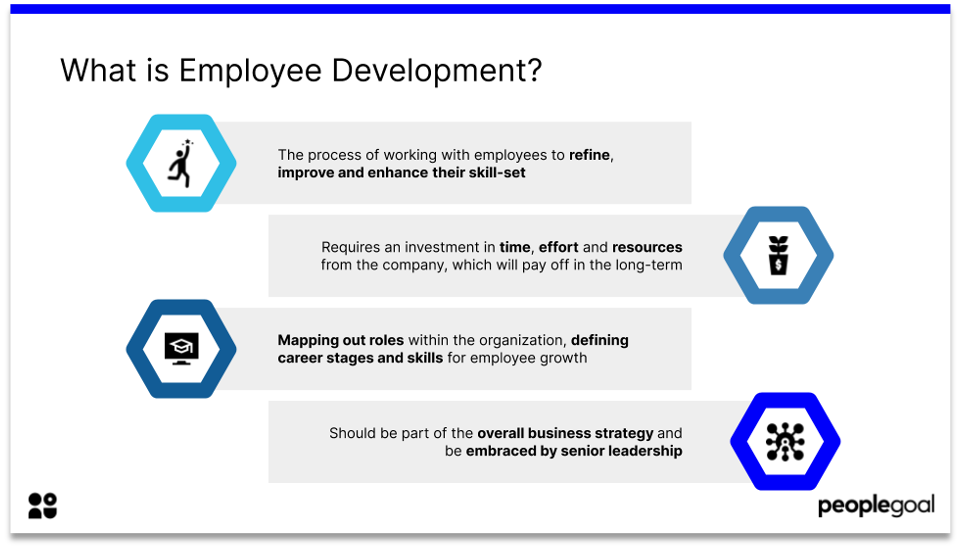
Employee development is the process of working with employees to refine, improve and enhance their skill-set. It's about helping employees to develop new skills to help them fulfil their roles to the best of their ability, whilst preparing them for the next career step. When done right, employee development requires an investment from the company in time, effort and resources - but this investment will certainly pay off in the long term. It is also vital to map out employee roles within the organization and define key career stages and skills that are conducive to employee growth. Finally, development should form part of the overall business strategy and be embraced by the senior leadership team.
The benefits of investing in employee development
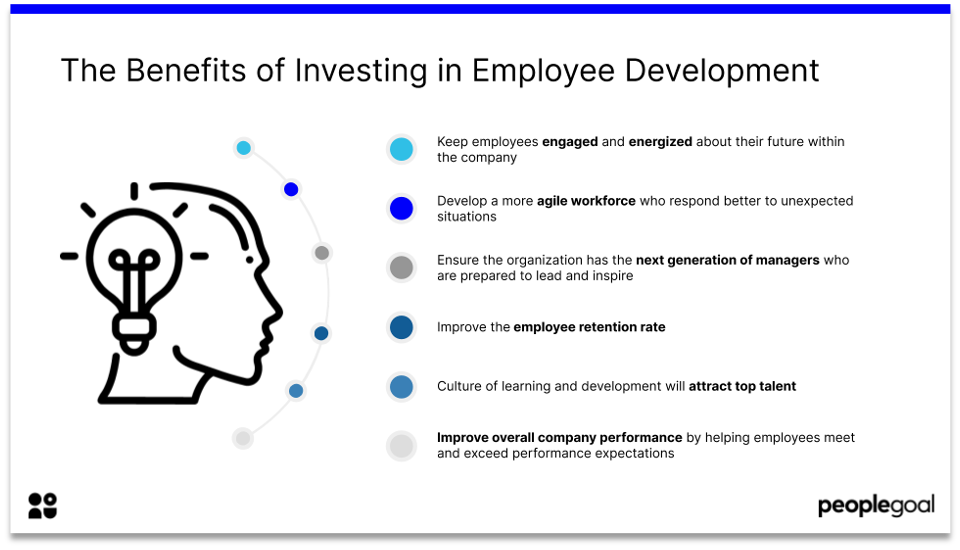
Keep employees engaged and energized about their future within the company
Develop a more agile workforce who respond better to unexpected situations
Ensure the organization has the next generation of managers who are prepared to lead and inspire
Improve the employee retention rate
Culture of learning and development will attract top talent
Improve overall company performance by helping employees meet and exceed performance expectations
Many companies have undertaken extensive engagement programs, but given less focus on development because they believe that through engagement you can improve retention. However, no matter how engaged an employee is, if they cannot see a clear career path they are unlikely to stay with the organization long-term.
Engagement and development should go hand-in-hand to be as effective as possible.
Current trends for employee development
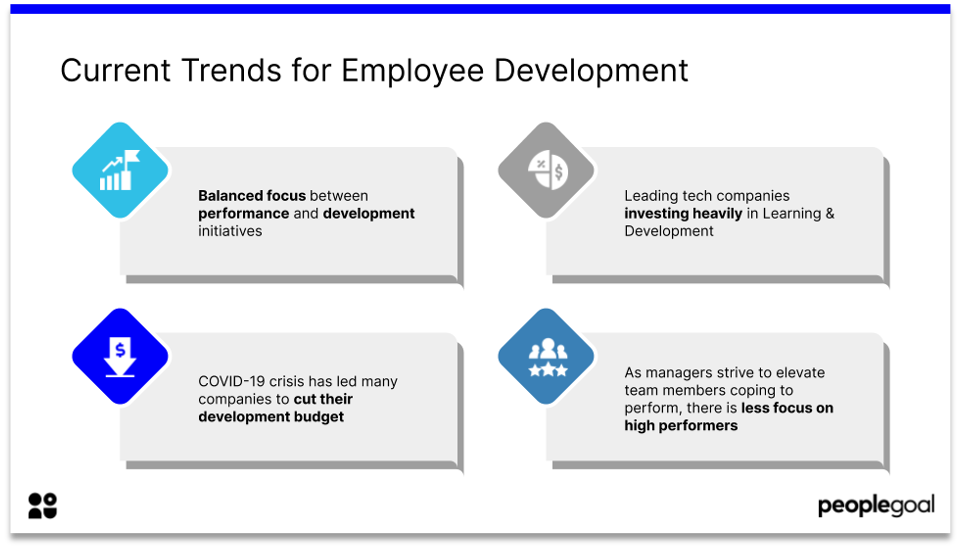
There is a more balanced focus between performance and development initiatives. Last year there was a heavier focus on performance through the Covid-19, but now employers are recognizing the benefits of sound development initiatives.
Covid-19 led many companies to cut their development budgets. Now as we move into 2021, it is important to reinstate the development budget to ensure company longevity and growth.
Leading tech companies are investing heavily in Learning & Development. The most successful companies don't stop at engagement. They provide great learning and career growth opportunities to their employees, establishing confidence in their future. High-growth organizations support their employees with real-time feedback and solid development initiatives, promoting a culture that encourages risk-taking and experimentation.
Another issue that has arisen recently is that managers spend more time coaching team members who are struggling to perform, and therefore dedicate less time and attention to moderate and high performers who consistently perform well. We need to focus on these employees as well and give them the opportunity to develop further, to avoid them feeling stagnated in their current position.
Best Practices
1. Performance-related training programs
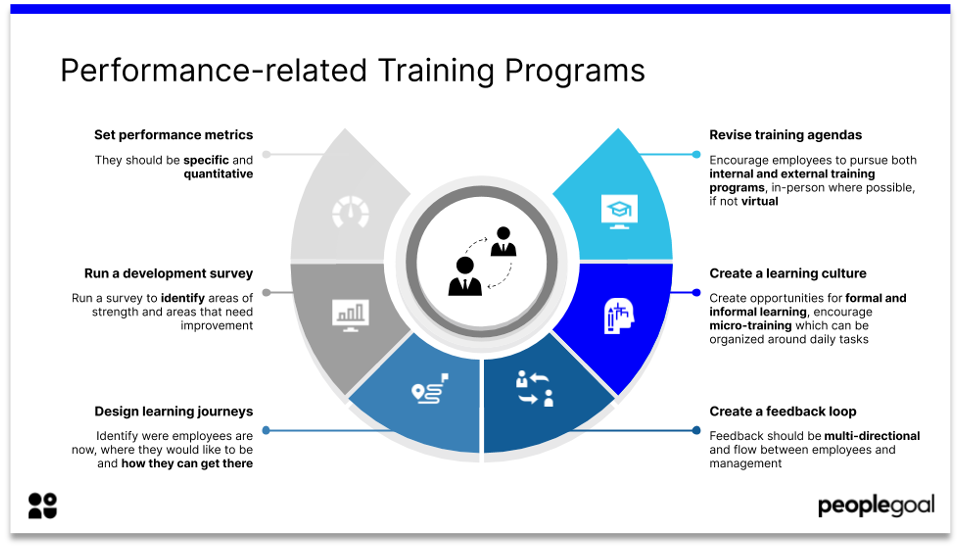
Once you have completed your performance processes, it is essential to enhance employee knowledge with performance related training programs. First of all, it is important to set performance metrics for all employees that are specific and quantitative. Employees can then complete a self-assessment as to where they currently stand in terms of performance. This can be achieved by running a development survey that will identify areas of strength and areas that need improvement. With this information, HR departments can design learning journeys for all employees where they clearly define where employees are now, where they would like to be and more importantly how they can get there. People teams should also look to revise the training agendas in response to the new global situation, for example employees now need to excel in a wide range of new 'soft' skills since the shift to remote working. Employees should be encouraged to attend both internal and external training programs, in-person where possible, if not virtual.
All of these strategies will help foster a learning culture within your organization, where employees are continuously encouraged to pursue personal growth. An organization with a culture of learning is a company that creates opportunities for formal and informal learning, and encourages micro-training which can be organized around an employee's daily tasks. At the same time, you should encourage a continuous feedback loop where feedback is multi-directional, and flows freely between employees and management. In practice, this means giving timely feedback to employees on their performance and regularly asking for feedback from all members of the organization.
When planning performance related training programs, bare in mind the following:
- In 2021, expect to see a combination of in-person and virtual training events, but with a heavier focus on virtual at the beginning of the year
- Train on skills that are relevant to the current situation (remote working, technology etc.)
- Training programs are appreciated and valued by employees
2. Development Plans
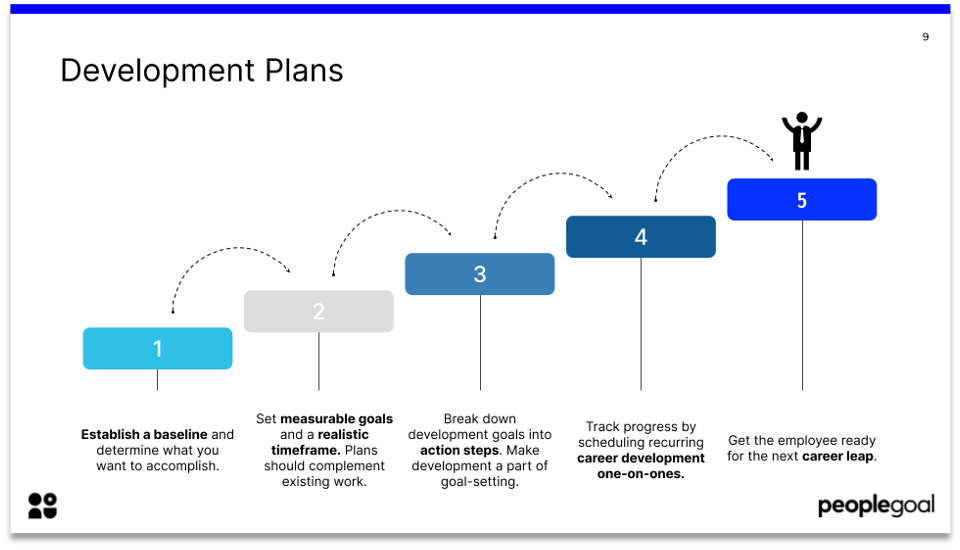
An effective employee development plan is a process that promotes individual growth and encourages employees to learn skills for their current role as well as develop an understanding of new roles and responsibilities in their organization.
First of all, establish a baseline and determine what you want to accomplish. Set measurable goals and realistic timeframe - development plans should complement existing work, and shouldn't be an after work activity or employees won't have the time to focus on it. Break down each development goal into action steps, and try to link the development plan into goal-setting, but make it clear that development plans and goal-setting are two separate things. Development plans are focused on acquiring the skills necessary to achieve the next career stage, whilst goals are for measuring what is expected from employees now in their current role.
Next, it is really important to track progress towards the next step. Schedule regular employee-manager career development one-to-ones to update progress. Doing all of this will help prepare the employee for the next career leap.
Q: Should every organization have a development plan?
It depends on your company culture and the type of business you want to run. For businesses that are very people-centric, development plans are a must. Larger organizations should also consider instating a thorough development process. For smaller organizations, growth and development happens more regularly and can be acquired from day-to-day interactions. Whilst it is not a prerequisite, it is definitely something to consider if you want to provide a more structured development path.
3. Career pathing
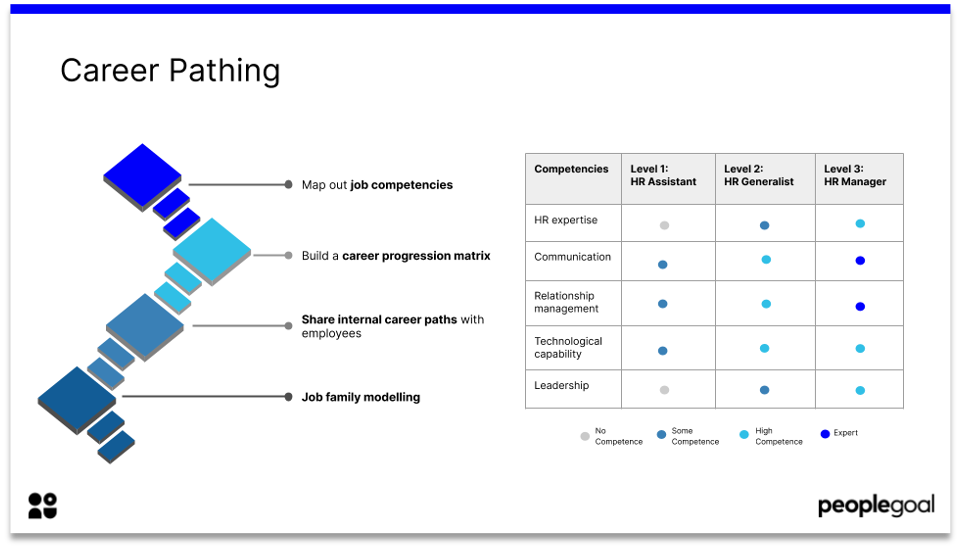
Career pathing is the process of mapping out all job roles within the organization and defining the grade and stage for each role. For example, you can build a build a career progression matrix to depict the skills and competencies required for each role in a specific 'job family'. Once you have done this, it is important to share the different career paths with employees and give them an overview of the types of skills they need to progress to the next career stage.
Benefits of job family modelling:
- Better understanding of exhibited behaviors at each level within your organization
- Job competencies can be used as a performance metric within performance reviews
- Improve transparency around expectations about future employee growth
3. Leadership development
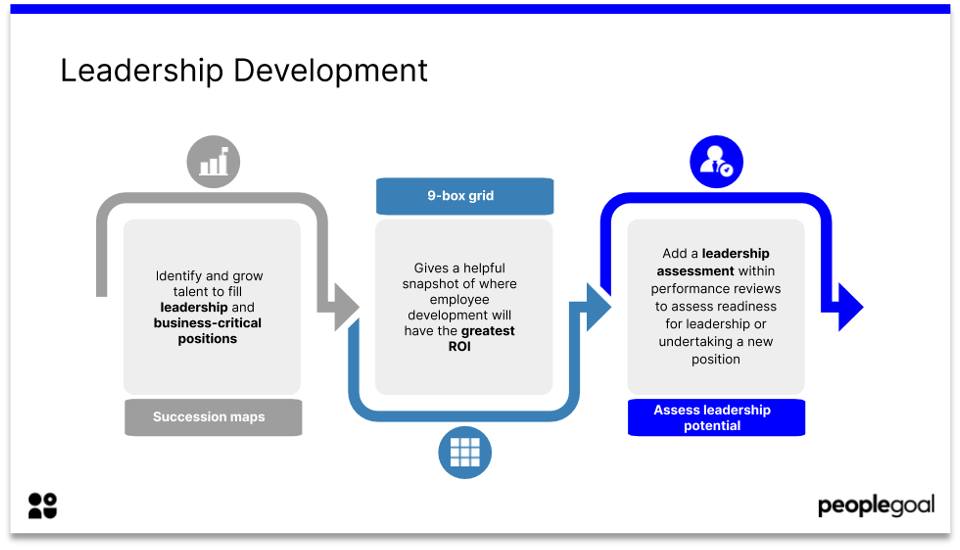
Succession maps - Identify and grow talent to fill leadership and business-critical positions. Identify high performers and set a clear career path for them.
9-box grid - Gives a helpful snapshot of where employee development will have the greatest ROI.
Assess leadership potential - Add a leadership assessment within performance reviews to assess readiness for leadership or undertaking a new position.
Why embrace employee development in 2021
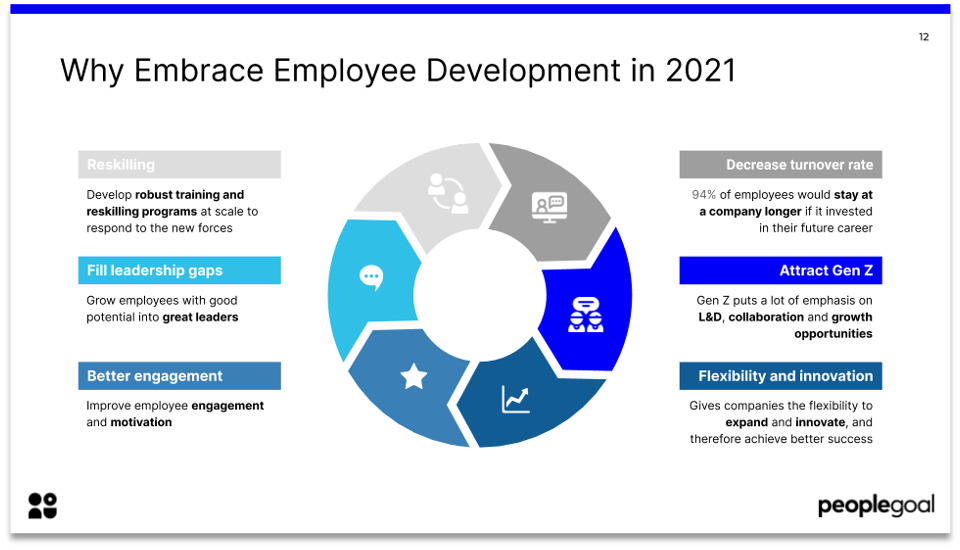
Reskilling: Develop robust training and reskilling programs at scale to respond to the new forces
Fill leadership gaps: Grow employees with good potential into great leaders
Better engagement: Improve employee engagement and motivation
Decrease turnover rate: 94% of employees would stay at a company longer if it invested in their future career
Attract Gen Z: The newest generation put a lot of emphasis on L&D, collaboration and growth opportunities
Flexibility and innovation: Employees on the path to development give companies the flexibility to expand and innovate, and therefore achieve better success
Key takeaways
It is essential to invest in employee learning and development
Encourage a culture of learning, where development is encouraged at every level
Create a clear development plan for every employee
Up to date skills and competencies are needed for company longevity and growth
Leverage succession planning to define talent and create a pipeline of successors
Want to learn more?
Enjoyed learning about employee development? Check out the full webcast here.
Catch up with our previous webcasts below:
Need some help kicking off with your onboarding, performance, engagement and development process? Book a demo with PeopleGoal today!
